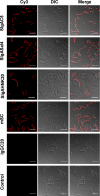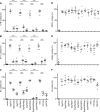Recognition of gram-positive intestinal bacteria by hybridoma- and colostrum-derived secretory immunoglobulin A is mediated by carbohydrates
- PMID: 21454510
- PMCID: PMC3089566
- DOI: 10.1074/jbc.M110.209015
Recognition of gram-positive intestinal bacteria by hybridoma- and colostrum-derived secretory immunoglobulin A is mediated by carbohydrates
Abstract
Humans live in symbiosis with 10(14) commensal bacteria among which >99% resides in their gastrointestinal tract. The molecular bases pertaining to the interaction between mucosal secretory IgA (SIgA) and bacteria residing in the intestine are not known. Previous studies have demonstrated that commensals are naturally coated by SIgA in the gut lumen. Thus, understanding how natural SIgA interacts with commensal bacteria can provide new clues on its multiple functions at mucosal surfaces. Using fluorescently labeled, nonspecific SIgA or secretory component (SC), we visualized by confocal microscopy the interaction with various commensal bacteria, including Lactobacillus, Bifidobacteria, Escherichia coli, and Bacteroides strains. These experiments revealed that the interaction between SIgA and commensal bacteria involves Fab- and Fc-independent structural motifs, featuring SC as a crucial partner. Removal of glycans present on free SC or bound in SIgA resulted in a drastic drop in the interaction with gram-positive bacteria, indicating the essential role of carbohydrates in the process. In contrast, poor binding of gram-positive bacteria by control IgG was observed. The interaction with gram-negative bacteria was preserved whatever the molecular form of protein partner used, suggesting the involvement of different binding motifs. Purified SIgA and SC from either mouse hybridoma cells or human colostrum exhibited identical patterns of recognition for gram-positive bacteria, emphasizing conserved plasticity between species. Thus, sugar-mediated binding of commensals by SIgA highlights the currently underappreciated role of glycans in mediating the interaction between a highly diverse microbiota and the mucosal immune system.
Figures





Similar articles
-
N-Glycans on secretory component: mediators of the interaction between secretory IgA and gram-positive commensals sustaining intestinal homeostasis.Gut Microbes. 2011 Sep 1;2(5):287-93. doi: 10.4161/gmic.2.5.18269. Epub 2011 Sep 1. Gut Microbes. 2011. PMID: 22067937 Review.
-
Secretory IgA N-glycans contribute to the protection against E. coli O55 infection of germ-free piglets.Mucosal Immunol. 2021 Mar;14(2):511-522. doi: 10.1038/s41385-020-00345-8. Epub 2020 Sep 24. Mucosal Immunol. 2021. PMID: 32973324 Free PMC article.
-
Binding of Clostridium difficile toxin A to human milk secretory component.J Med Microbiol. 1998 Oct;47(10):879-88. doi: 10.1099/00222615-47-10-879. J Med Microbiol. 1998. PMID: 9788811
-
Role of secretory IgA in the mucosal sensing of commensal bacteria.Gut Microbes. 2014;5(6):688-95. doi: 10.4161/19490976.2014.983763. Gut Microbes. 2014. PMID: 25536286 Free PMC article. Review.
-
Free and complexed-secretory immunoglobulin A triggers distinct intestinal epithelial cell responses.Clin Exp Immunol. 2016 Sep;185(3):338-47. doi: 10.1111/cei.12801. Epub 2016 Jul 26. Clin Exp Immunol. 2016. PMID: 27084834 Free PMC article.
Cited by
-
New concepts in the generation and functions of IgA.Nat Rev Immunol. 2012 Dec;12(12):821-32. doi: 10.1038/nri3322. Epub 2012 Oct 29. Nat Rev Immunol. 2012. PMID: 23103985 Review.
-
TNFRSF13B Diversification Fueled by B Cell Responses to Environmental Challenges-A Hypothesis.Front Immunol. 2021 Feb 17;12:634544. doi: 10.3389/fimmu.2021.634544. eCollection 2021. Front Immunol. 2021. PMID: 33679786 Free PMC article.
-
The role of the glycome in symbiotic host-microbe interactions.Glycobiology. 2023 Dec 30;33(12):1106-1116. doi: 10.1093/glycob/cwad073. Glycobiology. 2023. PMID: 37741057 Free PMC article. Review.
-
Gut microbiome and breast-feeding: Implications for early immune development.J Allergy Clin Immunol. 2022 Sep;150(3):523-534. doi: 10.1016/j.jaci.2022.07.014. J Allergy Clin Immunol. 2022. PMID: 36075638 Free PMC article. Review.
-
The role of secretory immunoglobulin A in the natural sensing of commensal bacteria by mouse Peyer's patch dendritic cells.J Biol Chem. 2012 Nov 16;287(47):40074-82. doi: 10.1074/jbc.M112.405001. Epub 2012 Oct 1. J Biol Chem. 2012. PMID: 23027876 Free PMC article.
References
Publication types
MeSH terms
Substances
LinkOut - more resources
Full Text Sources
Other Literature Sources
Molecular Biology Databases
Miscellaneous

